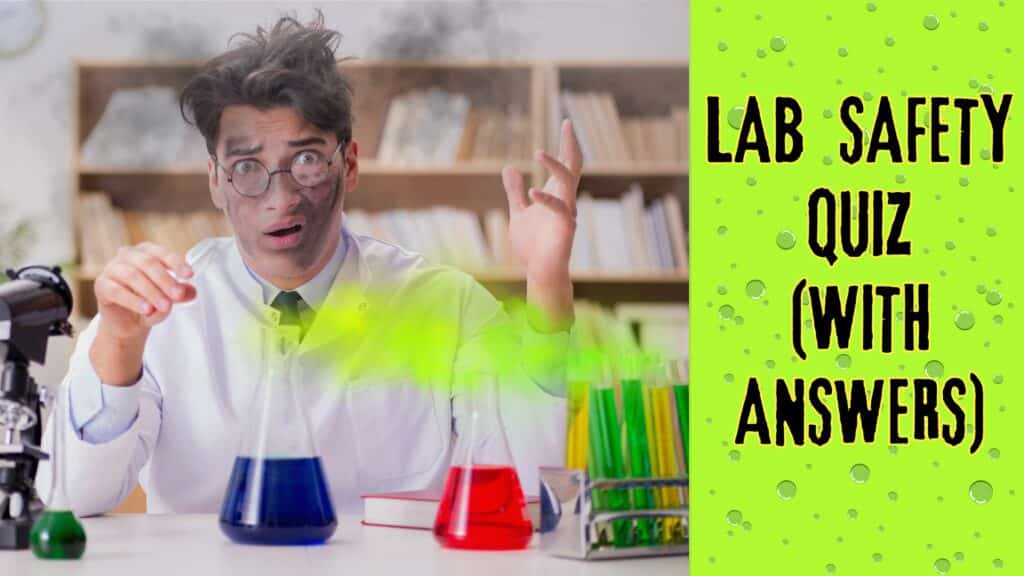
Hey there, lab rats and science cats! 🐭🐱 Ready to test the ‘chemistry’ between your brain and lab safety? Maybe you’re just ‘bubbling’ with excitement or hoping not to ‘crack’ under pressure. Either way, dive into this ‘elementary’ quiz and show that you’re not just an ‘accidental’ genius!
1. What’s the first rule when entering any lab environment?
2. Which piece of eyewear is essential when working with chemicals to prevent splashes?
3. What should you do immediately after any spill in the lab, no matter how small?
4. Which piece of lab equipment ensures that you have a safe open flame?
5. Why are shorts and sandals often prohibited in labs?
6. If a fire starts in a lab, what’s the most important initial action?
7. Which piece of equipment is designed to provide a rapid air change, protecting users from hazardous fumes?
8. In the event of a small fire, which equipment is most commonly used to put it out?
9. If a chemical gets into someone’s eye, what should be their immediate action?
10. Which famous scientist’s death was indirectly caused by working with radioactive elements without using proper safety equipment?
11. Why are food and drinks most often prohibited in labs?
12. What color flame does a Bunsen burner produce when it’s at its hottest?
13. In case of an emergency, what’s the most crucial piece of information present on a chemical bottle?
14. Why are latex gloves not always suitable in the lab?
15. What’s the primary purpose of a lab apron?
16. When heating a test tube, in which direction should you point it?
17. What is used to wash chemicals off a person in the lab?
18. True or false: Safety goggles are necessary when reading a textbook.
19. Which is the most hazardous type of chemical waste in a lab setting?
20. What technique should always be used to smell the odor of a chemical in a lab?
21. If a student accidentally cuts themselves with glass in the lab, what is the first thing they should do?
22. What does the acronym “PPE”, used commonly in labs, stand for?
23. When using a centrifuge, what’s the key safety rule to avoid imbalance?
24. If a chemical is labeled as “volatile”, what does this mean?
25. Which piece of lab equipment is crucial for studying microorganisms but could pose a burn risk?
26. What’s the term for a substance that can cause cancer?
27. What tool is best for retrieving small amounts of liquid from a container?
28. What is the primary reason long hair should be tied back in a lab?
29. What’s the role of an eyewash station?
30. Which type of footwear can increase the risk of injury from spills or dropped items?
31. Why are metal jewelry and watches typically discouraged in labs?
32. How should broken glass be disposed of in a lab?
33. Which gas is odorless and colorless, but can cause suffocation in large amounts?
34. True or false: You can use your mouth to pipette chemicals in a lab, but only with the instructor’s permission.
35. Which system classifies how potentially hazardous a chemical is based on health, flammability, and reactivity?
36. If someone is splashed with an acid, what should they do first?
37. What’s the key difference between disinfecting and sterilizing in a lab?
38. Why are mercury thermometers not commonly used in labs anymore?
39. Which type of fire extinguisher is recommended for electrical fires?
40. What do you call the practice of writing important details about a secondary container when transferring a chemical from its original container?
41. What potentially dangerous situation is indicated by a “sour” smell in a lab working with organic materials?
42. What type of hazard does a biohazard symbol indicate?
43. What safety measure ensures that a chemical reaction is carried out at the safest scale possible?
44. What is NOT the appropriate way to smell a chemical in the lab?
45. In case of power failure, what’s the primary concern in a lab with large, electrically-powered equipment?
46. What safety system uses water, foam, gas, or powder to control fires in a specific area?
47. Which lab device creates a vacuum and can be hazardous if its glass components implode?
48. What type of safety cabinet is used for work with infectious agents?
49. When should a lab coat be worn?
50. Which light gas which is often used in labs, is highly flammable and can cause an explosion if not handled properly?
51. How can you determine the specific hazards associated with a chemical you’re using?
52. Which lab equipment might pose a risk if used with volatile solvents due to the production of static electricity?
53. For which activity in the lab is it essential to use a blast shield?
54. Which part of the body is most susceptible to injury from chemical splashes?
55. If someone is exposed to a harmful chemical, aside from first aid, what’s another important step to follow?
You ‘reacted’ splendidly to that quiz! Want to continue the fun? Dive into more brain-teasing challenges with Trivia Bliss’s other quizzes. They’re ‘atomically’ awesome!
Leave a Reply